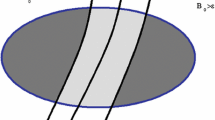Abstract
We derive the asymptotic behavior of the minimizers of the anisotropic Ginzburg-Landau functional of superconductivity, as the ratio between the largest and smallest effective masses is very big, hence the effective mass tensor becomes very degenerate.
Similar content being viewed by others
Notes
To prove \(\Psi ^{(1)}(\kappa A_1, \kappa A_2)\ne \emptyset \), it suffices to consider real single-valued functions \(g(x_3)\).
We can modify the above discussions to get results on \(f^3_{1,2,H}\).
When \(a(x')=b(x')\) holds in an open curve \(\Gamma \) on \(\partial U\), then the boundary condition does not hold on \(\Gamma \).
References
Chipot, M.: On some anisotropic singular perturbation problems. Asymptotic Anal. 55(3), 125–144 (2007)
Chipot, M., Guesmia, S.: On the asymptotic behaviour of elliptic, anisotropic singular perturbations problems. Comm. Pure Appl. Anal. 8(1), 179–193 (2009)
Chipot, M., Guesmia, S., Sengouga, A.: Anisotropic singular perturbations of variational inequalities. Calc. Var. PDEs 57(1), 29 (2018)
Du, Q., Gunzburger, M., Peterson, J.: Analysis and approximation of the Ginzburg-Landau model of superconductivity. SIAM Rev. 34(1), 54–81 (1992)
Kogan, V.: London approach to anisotropic type II superconductors. Phys. Rev. B 24(3), 1572–1575 (1981)
Pan, X.B.: On a quasilinear system involving the operator Curl. Calc. Var. PDEs 36(3), 317–342 (2009)
Pan, X.B.: Partial Sobolev spaces and anisotropic smectic liquid crystals. Calc. Var. PDEs 51(3), 963–998 (2014)
Pan, X.B.: Directional curl spaces and applications to the Meissner states of anisotropic superconductors. J. Math. Phys. 58(1), 24 (2017)
Schneider, T., Singer, J.: Phase Transition Approach to High Temperature Superconductivity. Imperial College Press/World Scienific Pub. Co., Beijing (2004)
Acknowledgements
This work was partially supported by the National Natural Science Foundation of China grant no. 11671143.
Funding
This study was funded by the National Natural Science Foundation of China Grants no. 11671143.
Author information
Authors and Affiliations
Corresponding author
Ethics declarations
Conflict of Interest
The author declares that he has no conflict of interest.
Ethical approval
This article does not contain any studies with human participants or animals performed by the author.
Additional information
Dedicated to Professor Michel Chipot on the occasion of his $$70^{th}$$70th birthday.
Publisher's Note
Springer Nature remains neutral with regard to jurisdictional claims in published maps and institutional affiliations.
Appendices
Appendix A: Proof of Lemma 6.5
Step 1. We use the notation \(F^a(x')=F(x',a(x'))\), \(F^b(x')=F(x',b(x'))\) and
Let \(\psi \) be an eigenfunction of \(\beta =\beta ^{1,2}_3(\mathbf{A})\) and has the form of (6.4). We show that u is an eigenfunction of the following equation
where \(a_j, c_j, d_j\) were given in (6.5), and
By the variational character of eigenvalue \(\beta ^{1,2}_3\) we have, for any \(v\in H^1(U,\mathbb C)\),
We compute
So we get
Since v is an arbitrary smooth complex-valued function, we get
where \(f=b-a\), \(g_j=B_j^b\partial _j b-B_j^a\partial _j a.\) For \(j=1,2\) we have
hence
which is (A.1).
Step 2. We write (A.1) as follows:
where \(U_j=c_j-b_j^2\) and \(V_j=\beta _j+e_j-\partial _jb_j=d_jb_j\). (A.3) can be written as (6.6), because
\(\square \)
Appendix B: Notation
Rights and permissions
About this article
Cite this article
Pan, XB. Singular limits of anisotropic Ginzburg-Landau functional. J Elliptic Parabol Equ 6, 27–54 (2020). https://doi.org/10.1007/s41808-020-00057-x
Received:
Accepted:
Published:
Issue Date:
DOI: https://doi.org/10.1007/s41808-020-00057-x
Keywords
- Superconductivity
- Effective mass
- Anisotropy coefficients
- Ginzburg-Landau functional
- Magnetic Schrödinger operator
- Singular perturbation
- Asymptotic behavior



